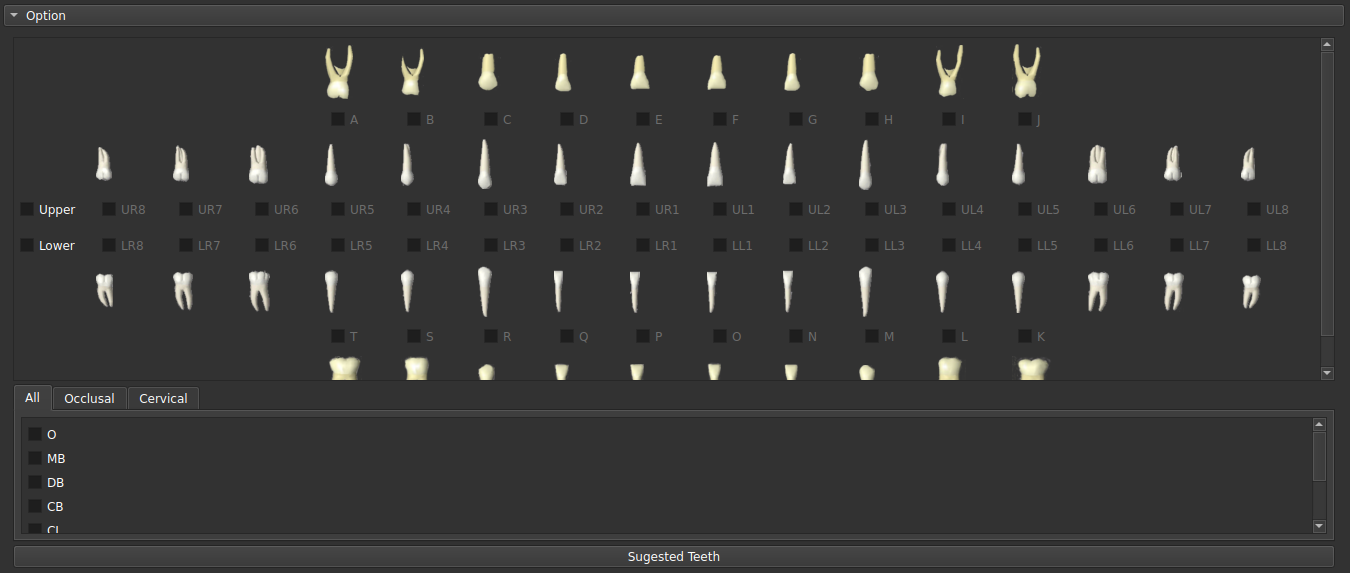Automated Standerized Orientation (ASO) is an extension for 3D Slicer to perform automatic orientation either on IOS or CBCT files.
ASO module provide a convenient user interface allowing to orient different type of scans:
- CBCT scan
- IOS scan
To select the Input Type in the Extension just select between CBCT and IOS here:
- Semi-Automated (to only run the landmark-based registration with landmark and scans as input)
- Fully-Automated (to perform Pre Orientation steps, landmark Identification and ASO with only scans as input)
| Mode | Input |
|---|---|
| Semi-Automated | Scans, Landmark files |
| Fully-Automated | Scans, ALI Models, Pre ASO Models (for CBCT files), Segmentation Models (for IOS files) |
To select the Mode in the Extension just select between Semi and Fully Automated here:
The Fully-Automated Mode
Inputsection is slightly different:
| Input Type | Input Extension Type |
|---|---|
| CBCT | .nii, .nii.gz, .gipl.gz, .nrrd, .nrrd.gz |
| IOS | .vtk |
To select the Input Folder in the Extension just select your folder with Data here:
The input has to be IOS with teeth's segmentation. The teeth's segmentation can be automatically done using the SlicerDentalModelSeg extension. The IOS files need to have in their name the type of jaw (Upper or Lower).
Test Files Available:
You can either download them using the link or by using the Download Test Files.
| Module Selected | Download Link to Test Files | Information |
|---|---|---|
| Semi-CBCT | Test Files | Scan and Fiducial List for this Reference |
| Fully-CBCT | Test File | Only Scan |
| Semi-IOS | Test Files | Mesh and Fiducial List Reference |
| Fully-IOS | Test Files | Only Mesh Reference |
The user has to choose a folder containing a Reference Gold File with an oriented scan with landmarks.
You can either use your own files or download ours using the Download Reference button in the module Input section.
| Input Type | Reference Gold Files |
|---|---|
| CBCT | CBCT Reference Files |
| IOS | IOS Reference Files |
To select the Reference Folder in the Extension just select your folder with Reference Data here:
The user has to decide which landmarks he will use to run ASO.
| Input Type | Landmarks Available |
|---|---|
| CBCT | Cranial Base, Lower Bones, Upper Bones, Lower and Upper Teeth |
| IOS | Upper and Lower Jaw |
The landmark selection is handled in the
OptionSection:
For IOS:
- if you select only Lower or Upper, the Upper or Lower jaw will be oriented in first and then the other jaw be oriented using the same transformation. (the morphology of the mouth will be kept)
- if you select both Lower and Upper, the Upper and Lower will be oriented separately (the morphology of the mouth won't be kept).
For CBCT:
For the Fully-Automated Mode, models are required as input, use the Download Models Button or follow the following instructions:
For CBCT (Details):
A Pre-Orientation and ALI_CBCT models are needed
To add the Pre-Orientation models just download PreASOModels.zip, unzip it and select it here:
To add the ALI_CBCT models go to this link, select the desired models, unzip them in a single folder and select it here:
To add the Segmentation model models just download model_segmentation.zip, unzip it and select it here:
You can decide the Extension that the output files will have and the folder where they will go in here:
Now that everything is in order, just press the
RunButton in this section:
The implementation is based on iterative closest point's algorithm to execute a landmark-based registration. Some preprocessing steps are done to make the orientation works better (and are described respectively in CBCT and IOS part)
Fully-Automated mode:
-
a deep learning model is used to predict head orientation and correct it. Models are available for download (Pre ASO CBCT Models)
-
a Landmark Identification Algorithm (ALI CBCT) is used to determine user-selected landmarks
-
an ICP transform is used to match both of the reference and the input file
For the Semi-Automated mode, only step 3 is used to match input landmarks with reference's ones.
Semi-Automated mode:
- an ICP transfrom is used to macth both of the reference and the input file by using the landmark
Fully-Automated mode:
Description of the tool:
Nathan Hutin (University of Michigan), Luc Anchling (UoM), Felicia Miranda (UoM), Selene Barone (UoM), Marcela Gurgel (UoM), Najla Al Turkestani (UoM), Juan Carlos Prieto (UNC), Lucia Cevidanes (UoM)
It is covered by the Apache License, Version 2.0:













